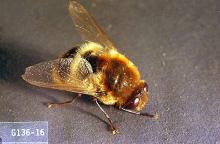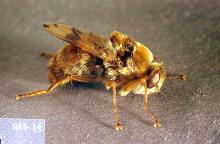Includes
Common bot (Gasterophilus intestinali)
Nose bot (Gasterophilus haemorrhoidalis)
Throat bot (Gasterophilus nasalis)
Pest description and damage Bot flies have four life stages: a free living non-biting fly, eggs attached to hairs on the animal, larvae migrating through tissues of the mouth, and the internal stage as larvae on mucosa of stomach lining and intestines. The main problem of the free living stage (bot fly) is the annoyance factor. On warm sunny days when bot flies are active, horses will fight the flies from morning until late afternoon. When the bot flies are present, horses will walk, run, bob their heads, and seek shelter in shaded areas. The larvae stages of the bot can do extensive damage to the horse's system.
- ivermectin oral liquid (Eqvalan)-Administer at 200 mcg/kg of body weight or 91 mcg/lb of body weight. Liquid delivered via nasogastric intubation or oral drench. Effective on a wide range of internal parasites. Not for use in horses intended for human consumption. Dispensed by veterinary prescription only.
- ivermectin paste (1.87%)-Administer at 91 mcg/lb (200 mcg/kg) of body weight. For oral use in horses only. May be used in horses of all ages, including mares at any stage of pregnancy. Stallions may be treated without adversely affecting fertility. Do not use in horses intended for human consumption. This product should not be used in other animal species as severe adverse reactions, including fatalities in dogs, may result.
- methoprene (0.27%) + pyrethrins (0.2%) + PBO (0.37%) + attractant (Ovitrol Plus II)-Kills adults and eggs. Apply spray directly to horse's coat, giving particular attention to legs, shoulders, flanks, neck and topline. To treat face, dampen a cloth with spray and rub on face and head, being careful to avoid eyes. Repeat every 2 months if necessary. Consult a veterinarian before using on debilitated, aged, pregnant, nursing or horses on medication. For preventing hatch of horse botfly eggs: Spray any infested areas directly at the first sign of visible eggs, paying particular attention to legs, shoulders, flanks, neck and topline. Spray to the point of dampness but not to the point of run-off of the spray. For a high degree of botfly egg control, spray animals every 3 to 5 days during the botfly season. Do not treat horses destined for food.
- MGK 264 (N-Octyl bicycloheptene dicarboximide) (21%) + permethrin 7.6% + piperonyl butoxide 14% (Prozap War Paint Insecticide Paste)-ADULT HORSES ONLY. Turn the applicator wheel ¼ turn to bring 2 grams of paste to the top of the applicator. Apply a 1-inch by 4-inch stripe down the front cannon of the leg, where insects tend to irritate. Repeat for the other three legs. The pesticide is released over a period of weeks. DO NOT REPEAT TREATMENT FOR 7 DAYS and then only if needed. Do not apply this product with a sponge. Use the applicator stick only. Do not apply to a wet animal as the paste will not adhere. Once applied to the hair, it cannot be wiped off; therefore do not use within one to two weeks before a show or event as it will affect appearance. If local irritation occurs, discontinue use. If irritation persists, consult a veterinarian. Not for horses intended for food.
- moxidectin (2%) (Quest)-Administer at 0.4 mg per kg body weight. For oral use in horses and ponies 6 months of age and older. Extreme caution should be used when administering the product to foals, young and miniature horses, as overdosage may result in serious adverse reactions. Do not use in sick, debilitated, or underweight animals. This product should not be used in other animal species as severe adverse reactions, including fatalities in dogs, may result. Not for use in horses intended for food.
- permethrin (0.50%) + pyrethrins ((0.25%) + piperonyl butoxide (2.5%) (Pyranha Equine Spray and Wipe)-Apply 1 to 2 ounces as a light spray mist to coat while brushing lightly against the hair. Avoid spraying in eyes or mucous membranes. Reapply in 10-14 days or as needed to maintain control of pest. Use on horses only. Do not use on foals under three (3) months of age. Do not use on horses intended for human consumption. Do not use on dogs or cats.



